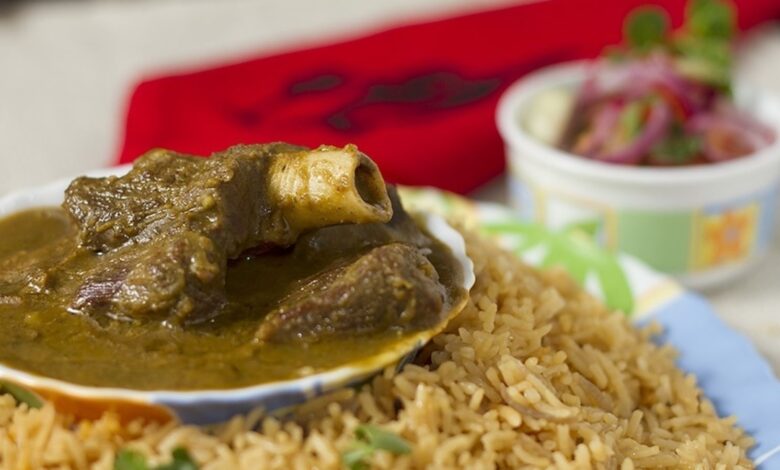Navroz Mubarak: From Iran to India, putting the spotlight on the travels and culinary influences of Parsi food

In today’s era of the ”glocal’, no experience is really out-of-reach. What usually does happen however, is a dilution of the same’s authenticity. While this does ensure that more eyes and mouths take to the experience, the uniqueness of the same begins to be lost. Today’s star of the show, the delectable Parsi cuisine, has somehow managed to skip the queue on this. Stepping into a Parsi eatery today, however big or however small, feels like being part of a time capsule and appreciably so. And it has always felt this way. Tracing the rich culinary influences of Parsi food, this Navroz(Photo: Swati Sani) On the special occasion of Navroz then, let’s take a look at the journey of this fusion cuisine and what sets it apart. Fusion is the foundation of Parsi foodParsi food has made its home in India after travels that have led it to steep itself in multiple waves of cultural and geographical influences. What we see on a typical Parsi menu today then, is actually a reflection of the evolving gastronomic experiences of the generations past. Parsi food at its core marries together the rich culinary traditions of Persian and Indian cooking, something which has been the product of a painful yet gainful past for the community, dating back to the 7th century. Dr. Rukshana Billimoria in her study, A Unique Odyssey of Parsi Cuisine: from Persia to Mumbai, establishes how Persians escaping the rampant religious persecution in their then-homeland, were granted permission to establish their Zoroastrian community in India a Hindu prince. Parsis — a descendant version of the term ‘Persians’ — found themselves establishing their base largely along the western coast of the country, namely in places like Gujarat, Maharashtra and Goa. Dr. Billimoria’s study asserts not just Persian and Indian influences, but also British and Portuguese inspirations in what makes Parsi cuisine stand out. A map depicting the trajectory of Parsi settlement in India(Photo: Zoroastrians.net) Persian kebabs, flatbreads and pilaf (pulao) were over decades, integrated with the saucy, spicy curries and gravies Indian cuisine stands deliciously templated . Incidentally, Persians were largely vegetarian till they took to meat as a survival tactic. Today, the layman sees Parsi food as a cuisine largely built around creamy eggs and meat — not just boti but also the bheja-kaleji-bukka — though vegetables also find a place of honour in several of their delicacies. As a matter of fact, fish-based dishes such as Patra Ni Machchi and Saas Ni Macchi, only emerged after the Parsis established themselves in India owing to Iran being a dry to semi-arid country. Saas Ni Macchi(Photo: YouTube/Sanjeev Kapoor) As British Raj commenced in India, Caucasian influences largely made itself evident in the dessert profile of Parsi food. Take the Lagan Nu Custard for instance, which is an improvisation on the English custard dessert via the staple addition of dry fruits. The same holds true for Chapat, which for all practical purposes is a pancake served with tea. So very English, but still uniquely Parsi. Lagan Nu Custard(Photo: YouTube/Sanjeev Kapoor) Simplifying the ‘khaatu-meetho-teekho’ dynamicKhaatu-meetho-teekho — these are the three interwoven cornerstones of the Parsi palette. The ample usage of vinegar, jaggery and barberry are the key contributors to the ‘khaatu’ and the ‘meetho’. The ‘teekho’ on the other hand is honoured through a heavy reliance on spices, some mainstream and others, quite niche. An absolute staple here are the spice mixes. While Parsi dhana jeera is a blend of coriander seeds and cumin seeds only, Parsi garam masala blends cloves and cinnamon with nutmeg and black peppercorns being optional. Dried rose petals(Photo: SPICEography) The iconic Parsi Dhansak masala, unlike its specific name, is actually used for a plethora of dishes and combines vegetable oil, chillies, coriander seeds, cumin seeds, curry leaves, turmeric, cinnamon, bay leaves, cloves, black peppercorns, mace, black mustard seeds and poppy seeds — a master spice blend if you will. Following close on its heels is the Parsi Sambhar masala, wildly different from the typical flavour understanding of sambhar. Also being added to the well-known Dhansak, the Parsi Sambhar masala is a blend of black mustard seeds, chilli powder, cinnamon, black peppercorns, cloves, turmeric, fenugreek seeds and sesame oil. Parsi Bhonu(Photo: YouTube/Sanjeev Kapoor) Zafferan (saffron), Zard Chubeh (turmeric), Gol Ab (rose water) and Shambalileh (fenugreek) are among the more ‘mainstream’ spices used in Parsi cooking while Nanaa (dried mint), Somagh (sumac), Limoo Amani (dried limes), Rob-e-Anar (pomegranate molasses) and Kashk (dried buttermilk) make for the more niche picks. Advieh or Persian mixed spice, comprising of nutmeg, rose petals, cumin, cardamom, coriander, cinnamon and black pepper is also a staple when it comes to the typical Parsi spice lineup. The absolutely avid use of coconut as the base flavour and dry fruits for garnishing, is as signature as it gets. Advieh or Persian spice mix Decoding the DhansakIf there is anything to take away here, it is that Parsi food is so much more than just Dhansak. That being said, the meaty, hearty, flavourful concoction is synonymous with the idea of a Parsi meal. Dhansak essentially represents the best of all the worlds combining the magic of lentils (the ‘dhan’), vegetables (the ‘sak’), with mutton, stewed in a deeply layered, rich gravy. This is traditionally served with caramalised brown rice and a refreshing Kachumbar salad. Dhansak(Photo: Simply Bhonu) As exciting as this sounds, you may be surprised to know that the cultural context of the Dhansak is actually grim. The dish is reserved for the fourth day of mourning, after a loved one’s passing. Other sources also link Dhansak as the primary item of sacrifice during the ‘gambhar’, which referred to celebratory, communal dining in honour of the changing seasons. As you prepare to feast on your most loved Parsi delicacies, we wish everyone a blessed Navroz!







